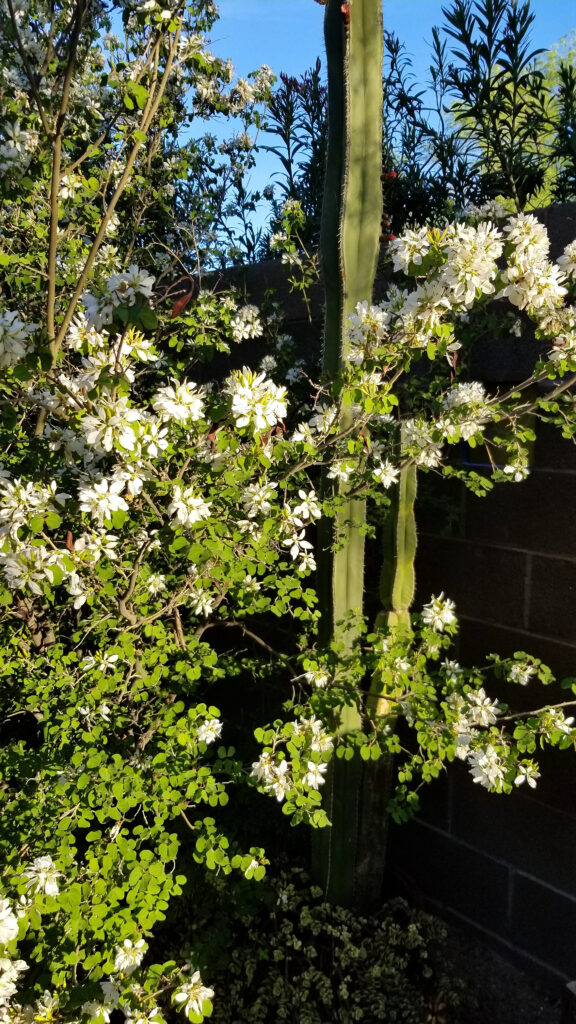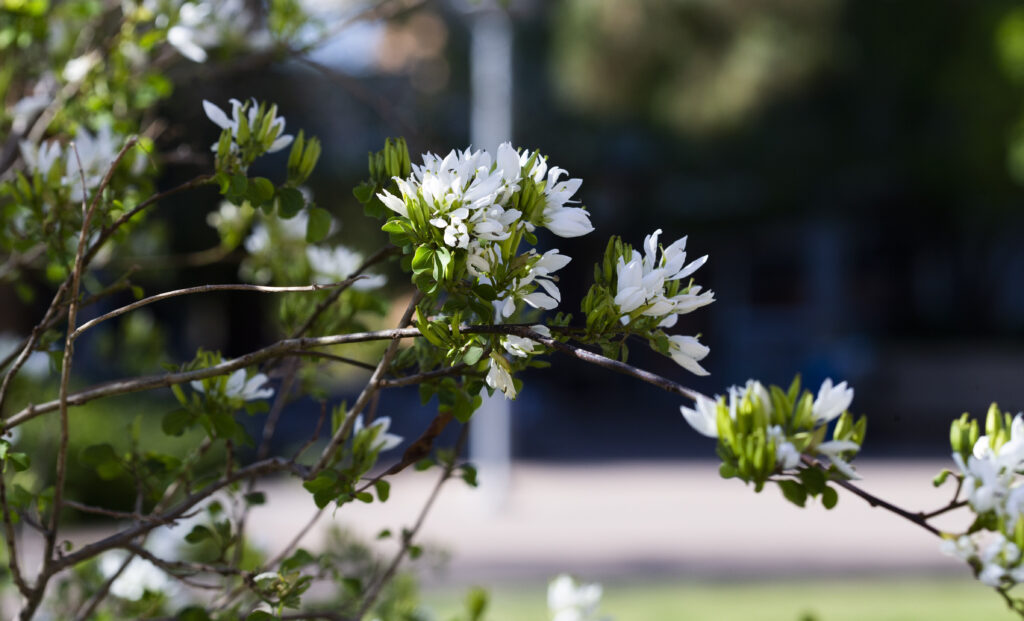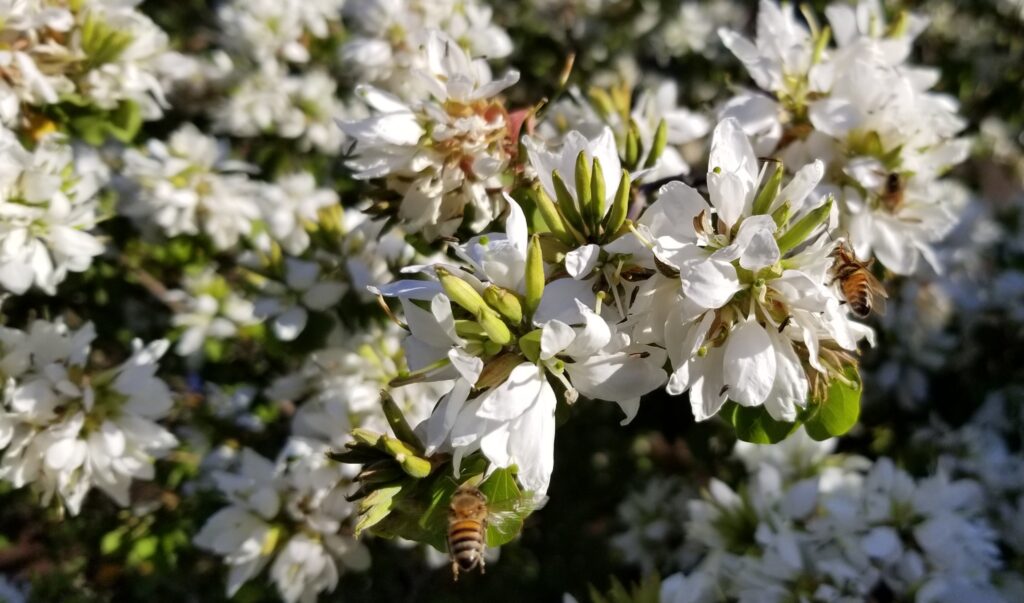This month, our plant of the month blog features a plant description from a newly revised book, Cool Plants for Hot Gardens by Greg Starr! In his book, Greg features 150 water-smart choices for the Southwest – it’s no wonder why we like the book so much here at Water – Use It Wisely! He includes a fun category of the “Etymology” or the origin of the scientific name, as well as “Field Notes” he has taken (and somehow kept track of) that describe where he found or has observed the plants growing in habitat.
Chihuahuan Orchid Tree, Bauhinia lunarioides
AT-A-GLANCE
Attracts bees, butterflies.
|
Etymology
American botanist Sereno Watson chose an appropriate species name, as lunarioides is derived from the Latin lunaris-, a reference to the crescent shaped leaflets.
Field notes
I traveled the old, cobblestone road up the microwave hill near Mamulique in Nuevo Leon to see this small tree with its distinctive butterfly-like leaves. The plants are tough as nails, surviving the harsh desert environment of northeastern Mexico. Plants of Bauhinia lunarioides are found growing among desert scrub vegetation, mainly on rocky, limestone soils in Coahuila and Nuevo Leon, from about 1,500-6,000 feet elevation.
Description
This Chihuahuan Desert native is a large shrub that can be pruned as a small tree growing to 15-18 feet tall and 10-15 feet wide. Deciduous leaves are alternate on the branches and composed of two 1-inch-long by 1-inch-wide leaflets that resemble the wings on a butterfly. In spring, the crown is covered with showy clusters of white or occasionally pink flowers. These flowers, measuring about 1-inch across, occur in clusters of 6-10, and attract butterflies and bees. A 2-inch-long woody pod forms after flowering.
Culture
Chihuahuan Orchid Tree, also called Anacacho Orchid Tree is perfect for USDA zones 8b-11 being hardy to 15⁰ F. While plants will tolerate some afternoon shade, best results are obtained when they are placed in full sun or reflected heat. The growth rate is moderately slow, taking several years to reach small tree stature. Although drought tolerant, surviving on 10-12 inches of annual rainfall, plants will grow faster and pump out more flowers for a longer period if given a thorough soaking every 10-14 days in spring and summer. They require very little maintenance and can be left alone to grow as large shrubs or pruned to tree form.
Identification
Bauhinia lunarioides has smaller leaves and flowers than Bauhinia macranthera.

Landscape Application
Given time, these can develop as beautiful, small, thornless patio trees. Although they go deciduous in winter, sweeping leaf litter from hard surfaces is an easy job that will occupy energetic kids for an hour or so. The trees mix easily with mini-oasis favorites or hard-core desert plants. Ideal companion plants would include the following: Agave species, Ageratum corymbosum, Asclepias subulata, Buddleja marrubiifolia, Hesperaloe campanulata, Leucophyllum candidum, Salvia farinacea, and Zinnia grandiflora. If you have the pink-flowered form be sure to match it up with plants that have a compatible flower color.
Precautions
Young growth is susceptible to rabbit damage, so screen your plants until the main trunks are past nibbling size. Keep the tops of the tree thinned to minimize the stress on the trunk.
~ ~ ~ ~ ~ ~ ~ ~ ~ ~ ~ ~ ~ ~ ~ ~ ~ ~ ~ ~ ~ ~ ~ ~ ~
Did you know that up to 70 percent of water use is outdoors? That’s why we love desert plants and feature them each month. It’s still a great time to plant non-tropical plants in your landscape, and you can learn more about Damianita and other plants on our Arizona Low-Water-Use Plants page. Visit our page on Choosing and Planting Low Water-Use Plants for tips on plant selection and how to plant properly. Also, be sure to read through all of our featured Plant of the Month blogs!
Water – Use It Wisely is proud to feature guest bloggers who write about topics related to water and water conservation. Greg Starr is a horticulturist and the owner/manager of Starr Nursery located in Tucson, AZ. It is a mail order nursery where you can shop online. Greg has traveled extensively in Mexico and the southwestern United States to study native plants for their potential landscape use in desert regions of the world. In 2009, Greg entered the world of literature as an author with the publication Cool Plants for Hot Gardens. This book was revamped and revised in its second edition published in December of 2021. The book is available online.


